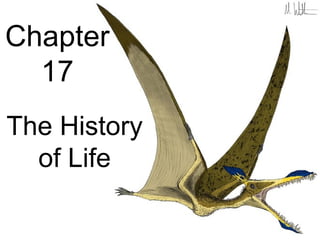
Biology - Chp 17 - History Of Life - PowerPoint
- 1. Chapter 17 The History of Life
- 2. 17-1 The Fossil Record • Studying life’s history is one of the most fascinating and challenging parts of biology
- 7. 17-1 The Fossil Record • And researchers go about it in different ways
- 8. Fossils and Ancient Life • From the study of fossils, Paleontologists infer what past life forms were like and the environment that they lived • They also classify them and arrange them in the order in which they lived • Together, all of this information is called The fossil record
- 9. What the Fossil Record Shows • Fossils occur in a particular order • Life has changed over time • More than 99 percent of all species that have ever lived have become extinct
- 10. Extinct • When a species dies out
- 11. How Fossils Form • For a fossil to form, either the remains of the organism or some trace of its presence must be preserved • The formation of fossils depends on a precise combination of conditions • Most fossils form in sedimentary rock
- 15. Interpreting Fossil Evidence • More often than not, a Paleontologist must analyze and interpret a fossil from a few fossil bits • When they study fossils, they look at anatomical similarities and differences between the fossil and living organisms • Also a fossils age is extremely important • Paleontologists determine the age of a fossil using 2 techniques
- 16. 1. Relative Dating • The relative age of a fossil is determined by comparing its placement with that of fossils in other layers of rock
- 18. Index Fossils • Used to compare the relative ages of fossils
- 20. To be used as an index fossil, a species must 1. Be easily recognized 2. Existed for a short period of time 3. Have a wide geographical range
- 21. 2. Radioactive dating • Used to determine the absolute age of rocks using radioactive elements • Radioactive elements decay or break down into non-radioactive elements at a steady rate
- 22. Half life • The length of time required for half of the radioactive atoms in a sample to decay • In radioactive dating, scientists calculate the age of a sample based on the amounts of remaining radioactive isotopes it contains
- 24. Geologic Time Scale • Paleontologists use divisions of the Geologic time scale to represent evolutionary time
- 25. Eras • Divides the time between the Precambrian and Present
- 29. Ordovician
- 30. Silurian
- 31. Devonian
- 32. Carboniferous
- 33. Permian
- 34. Triassic
- 35. Jurassic
- 36. Cretaceous
- 37. Tertiary
- 38. Quaternary
- 39. What would it take to bring on a new geological era? 1. Change the atmospheres composition, thus modifying plants 2. Change the distribution and diversity of species, thereby changing the future fossil record 3. Acidify the oceans, which will modify the mineral deposits on the ocean floor • Does this sound familiar?
- 40. New era being proposed • “Anthropocene” • New era characterized by the domination of the planet by one species…us.
- 42. 17 – 4 Patterns of Evolution • Biologists often use the term macroevolution to refer to large- scale evolutionary patterns and the processes that occur over long periods of time
- 43. Six important topics in macroevolution are 1. Extinction 2. Adaptive radiation 3. Convergent evolution 4. Coevolution 5. Punctuated equilibrium 6. Changes in developmental genes
- 44. Extinction • More than 99% of all species that have ever lived are now extinct • Usually extinctions happen the way Darwin proposed • Sometimes mass extinctions wipe out entire ecosystems • Many times mass extinctions are followed by a burst of evolution that produces many new species
- 45. Adaptive Radiation • When a single species or a small group of species has evolved into diverse forms that live in different ways
- 47. Convergent Evolution • When unrelated organisms come to resemble one another Ex.) sharks and dolphins
- 49. Q: How does this happen? A: Adaptive radiation can happen in different places and times but in ecologically similar environments
- 50. Analogous Structures • Structures which look and function similarly but are made up of parts that don’t share a common evolutionary history
- 52. Coevolution • The process in which 2 species evolve in response to changes in each other Ex.) plants + pollinators plants + herbivorous insects bats + moths
- 54. Hammer Orchid
- 55. Bats vs. Moths An Evolutionary Arms Race
- 56. Rough Skinned Newt vs. Garter Snake
- 57. Punctuated Equilibrium • There is no question among Biologists that evolution has happened and is happening today • There are however questions about how fast evolution happens • Darwin thought that evolution was slow and steady. He called this idea Gradualism • This idea is supported by fossil evidence • However, the fossil record also shows changes that have happened over relatively short periods of time (hundred of thousands-even million-of years)
- 58. Punctuated Equilibrium • Long stable periods of equilibrium interrupted by brief periods of more rapid change • This may be the result of genetic isolation
- 60. Developmental Genes and Body Plans • Biologists have long suspected that changes in the genes for growth and differentiation during embryological development could produce transformations in body size and shape • Until recently, researchers had only limited ability to affect gene activity in embryos
- 61. Developmental Genes and Body Plans • We can now perform experiments with gene expression by turning genes on or off and examining the results • Small changes in the timing of cell differentiation and gene expression can make the difference between two completely different phenotypes
